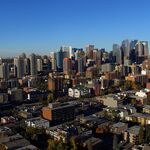Here's my take on densities, a similar but slightly different analysis. I calculated densities with three changes; I used buffered dissemination area dwelling unit density. The reasons:
- Census tracts can be quite large and often contain non-residential land, such as parks or employment areas. DAs are smaller so this effect is much less.
- However, DAs are so small that sometimes they are quite silly; there's one that's only the inside of a single townhouse complex in Bridlewood. It's as dense as Kensington, but that's not meaningfully dense living. So I used a buffer around the DA (centroid-to-centroid), calculating the densities for the DA plus all others within a buffer (actually three buffers - 250m, 500m and 1km and averaged the three) to produce a measure of the density in context.
- Further, I find that dwelling unit density is more meaningful for the 'feel' of urbanity than population density; inner cities have smaller households, and two suburbs can feel very similar -- but one has a lot of empty nesters and one has a lot of multigenerational families. A 5 person household does use more resources or make more trips than a single person household, but likely not 5x as much.
One thing that all of these density measures are missing is any non-residential information; downtown Calgary has relatively low density because the tall office towers pushed out all of the residential buildings. That's a problem everywhere (in Canada; other Anglosphere statistics agencies release employment information that can be used in density measures).
The cutoff that is roughly 10K people per sq km is 5.5K using this measure; I broke densities into seven bins to capture more detail.
- Low density (<100): Rural, industrial and park land as well as exurban-style country residential and the like. 8% of CMA population
- Suburban low (100-1000): Either relatively large lot (e.g. 10K sq ft) suburbia (up to about 4 units per acre) or somewhat more traditional suburbia with a lake, golf course, ravines, etc. 28% of CMA population.
- Suburban high (1000-2000): More 'typical' suburbia as we think of it; the largest category - around 38% of CMA population. 73.7% of CMA residents live in these first three categories.
- Semi-urban low (2000-3500): Common in pre-1930 or so communities, or in areas with substantial townhouse/midrise populations. 12.7% of CMA population.
- Semi-urban high (3500-5500): Approaching the high-density line; 14-22 units per acre. Requires multifamily, even if just walk-up apartments. (6.6% of pop)
- Urban low (5500-10000): High density but not necessarily tower-based. (4.9% of pop)
- Urban high (10,000 and up): High density, pretty much requiring towers to achieve. (2.2% of pop)
Here's a map of Calgary to give you a sense of what these categories look like:
A closeup of the inner city including all of the DAs in the top 3 categories:
Here's how the major CMAs stack up in these categories by share of population:
One interesting takeaway is how similar Calgary and Edmonton are with the low rate of Semi Low (white). I suspect this is because we grew much faster than other places; both Calgary's and Edmonton's 1931 population was ~4% of our current population, where it's around 8-12% in most of the places on the chart above, 14% in Toronto and Hamilton, 16% in Montreal and 21% in Winnipeg and Halifax.
We also have a low amount of population in the lowest density areas; I suspect that the big 3 are so low because they've basically filled up their CMAs and there's not much rural land included, but we have plenty of rural land -- but it's just very sparsely populated both because of our late population growth and because we're so dry that a workable farm/ranch is just a lot more acreage than elsewhere.
Here's what the big 3 look like as maps:
You can see how Montreal has a massive area of that high density -- a plateau if you will - but it's at a lower intensity than the tower-filled cores (and some suburban nodes) of Vancouver and Toronto. Montreal is also the leader in the third tier of near-high density.
Of course, the percentages hide how many more people are in high density in the big 3; here's the share of people at high density (the top 2 brown and dark brown categories) by CMA with the big 3 split into the two top categories.




